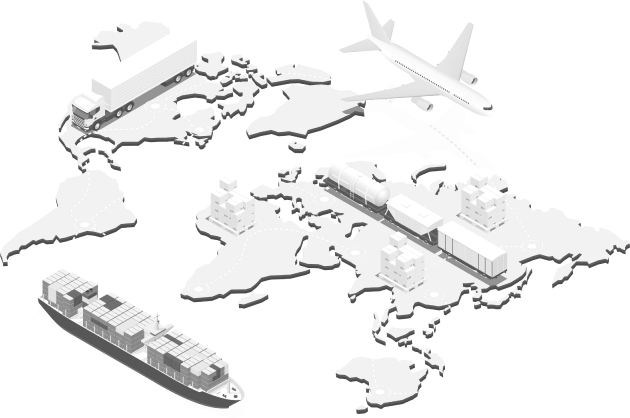
On our end, as a preeminent global logistics provider, we do everything we can to move freight safely, but there are things you can do to improve the performance of your packaging in advance of the actual shipping and handling process.
Rough conditions in the air, on land; or at sea, and fluctuating humidity, and extreme temperatures are just a few things that can impact packaging integrity and the safety of your freight. Extreme temperatures and humidity also reduce packaging strength.
We know how damages can impact you and your customers. In fact, a recent survey shows when a shipment is damaged, on average companies lose:
- Time: Up to five hours of time is spent dealing with a damaged shipment;
- Money: At least 25 percent of a shipment’s value is never recouped when damage occurs; and
- Customers: Over 50 percent of companies have lost a customer or some business due to damages.
Is Your Freight Ready for its Trip?
As mentioned, adverse conditions can impact packaging integrity. Let’s take a look at tips and hints from our logistics experts to identify the best options for packaging your freight in the areas of internal packaging, shrink wrapping, using corrugated cardboard, and labeling.
Internal Packaging
Some freight will benefit from the use of internal packaging between the product and container to gain adequate protection: It will protect products from dynamic shock and vibration; prevent shifting of interior materials by occupying empty space, and shield items from external factors such as weather or changes in temperature.
Here are some techniques to consider:
BUBBLE CUSHIONING: With its ability to be flexible and wrap around any object, use this lightweight, shock-absorbing cushioning to package sensitive or irregular-shaped items.
LOOSE FILL: Loose filling helps stabilize products. Use these materials to fill empty space in your packaging while providing a flexible, protective environment.
PAPER FILLING: Providing more stabilization than loose fill, use paper to fill, brace, and wrap your product to prevent shifting.
PAPER HONEYCOMB: Paper honeycomb is lightweight, but highly structured, enforced paper formed into hexagonal shapes. Use paper honeycomb to provide additional protection when stacking, layering, blocking, bracing, or filling space around products.
FOAM CUSHIONING: Lightweight, dense, and often customizable to form fit products, foam cushioning protects against dynamic shock and vibrations and can brace, stabilize, or immobilize freight to reduce damage.
External Packaging
Most commodities require durable external packaging for adequate protection when shipping. Use external packaging to: Protect freight from external elements such as weather or drastic changes in temperature while in transit; prevent shifting and help brace freight by tightly loading and securing your commodity on a pallet, and promote safe and efficient handling of freight to prevent damage
CONSTRUCT STRONG CRATES: Not all crates are built the same. Construct crates with quality lumber and with attention to strength. It’s not the amount of material used, but how it’s used.
PALLETIZE FREIGHT: Affix freight to a pallet. Pallets help keep loose freight together to prevent shifting on the dock or in transit and allow for the safest and most effective handling of freight.
RECOMMENDED PALLET STRUCTURE: 40-42″ W x 48″ L, standard industry size, four-way entry, compatible with common freight handling equipment. Do not use pallets that have been damaged or have deteriorated in quality.
FREIGHT HANDLING EQUIPMENT: Forklifts and pallet jacks are the most commonly used equipment to load and unload the freight. Shipments built on pallets facilitate safe, efficient, and damage-free handling.
PROTECT MATERIALS WITH CARDBOARD: Corrugated cardboard is a durable and strong material used for shipping-freight protection due to its construction of high-quality, air-dried paper in a flute or arched pattern layered between smooth sheets. Cardboard is highly customizable, cost-effective, and comes in many different shapes and strengths. Corrugated cardboard also serves as an effective resource to help stabilize vertically stacked freight or cartons is with as it protects the top, bottom, and middle layers of a shipment; it stabilizes palletized freight and eliminates shifting that can damage freight in transit; and it absorbs the impact of vibrations, protects against moisture, provides structural support, and prevents compression and bending.
EDGE BOARDS, BAND & WRAP: Edge boards, bands, and plastic wrap are durable freight protection materials that can help enable shipments to be affixed securely to a pallet to stabilize freight, increase compression strength, and protect against external elements. Use these freight protection materials to prevent freight from shifting when being transported on the dock or in transit in the trailer; secure aligned, column stacked packages, and corners precisely to retain full strength; and protect all surfaces – top, bottom, middle, and edges – of freight
EDGE BOARDS INCREASE STRENGTH: Apply edge boards, also referred to as corner boards, to palletized freight. These angled pieces of materials which fit over the edges of boxes, crates, bundles, and other shipments prevent pressure from bands or other external impacts that can cause damage. They also help balance and tighten a shipment’s column stack structure; reduce damages by protecting corners; and increase the overall compression strength of palletized freight.
BANDS SECURE FREIGHT TO PALLET: Use quality bands to secure freight tightly to a pallet to help stabilize your shipment. Fasten the bands tightly around the edge boards and thread the band beneath the top deck boards of the pallet to help anchor the shipment to its pallet. Bands protect from shortages or losses by keeping loose shipments contained together; they stabilize cartons and materials on a pallet to prevent damage from shifting, and immobilize cartons within palletized freight to be more easily handled
SHRINK WRAP KEEPS FREIGHT TOGETHER: Shrink wrap your freight for additional protection from external elements so it can be delivered safely and in the same condition it was sent. This technique protects against weather damage and shields freight from fluctuating changes in temperatures; secures loose packages and helps anchor freight to its pallet, and can be used along with bands to tightly affix freight to a pallet to prevent the pallet from disconnecting from freight while being handled or transported.
Shrink wrap also helps adhere freight to a pallet. Tie shrink wrap to the pallet and begin wrapping your freight starting at the bottom of the pallet. Tightly wrap completely around the pallet at the bottom, then middle, then finish at the top. For the ultimate shrink wrap protection, double wrap freight in the opposite direction, also beginning at the bottom with shrink wrap tied to the pallet.
Proper Labeling
To be accepted for transportation, freight must be marked clearly with shipping labels. Here are a couple of things to remember: Ensure labels are properly affixed to freight, clearly labeled, and/or tag freight; and affix labels at the top, side, or end of freight; ensure that labels are secured to freight with adhesive or metal staples. Also, each package or lose piece of freight should be marked clearly and indicate the following: Shipper and consignee name, phone number, and address
METAL FREIGHT: Fluctuating temperatures can cause labels to peel off metal freight and tags may fall off during loading and unloading. Use a metal or paint marker to identify and label steel or other metal freight. Finally, include the PRO number, purchasing order (PO) number, or other identifying information to enable all shipment handlers to identify.
For More Information
If you would like a comprehensive packaging review, contact Prime Logistics today by calling 305-592-2044 or visit our website www.primeilogisgicsgroup.com.
We also wish to thank XPOLogisitcs for serving as a source of references for this article.


